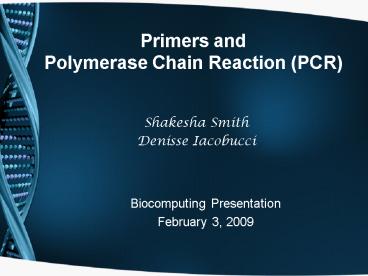Primers and Polymerase Chain Reaction PCR PowerPoint PPT Presentation
Title: Primers and Polymerase Chain Reaction PCR
1
Primers and Polymerase Chain Reaction (PCR)
- Shakesha Smith
- Denisse Iacobucci
Biocomputing Presentation February 3, 2009
2
What is PCR and why is it important?
- PCR utilizes a DNA polymerase to amplify a target
sequence of DNA exponentially. - Importance?
- -DNA cloning for sequencing
- -Analysis of genes
- -Diagnosis of hereditary and infectious diseases
- -Genetic fingerprinting
- Benefit Results in several copies of the target
sequence in a few hours - Limitation Primer lacks 3 to 5 exonuclease
activity
3
What is needed to do PCR?
- DNA template The DNA to be amplified
- Primers Complementary to the 3 and 5 ends of
the DNA template - DNA polymerase Synthesizes the DNA
- dNTPs Building blocks which the polymerase uses
to synthesize the DNA - Buffer solution Creates the optimal environment
for the reaction to occur - MgCl2 Activates the polymerase
4
Primer
- Contains specific nucleotides for replication
region - Initiates DNA replication
- Anchors DNA Polymerase
- PCR
- DNA clone
5
Use in PCR
- Start DNA replication reaction
- Makes directed sequencing reactions
- Amplification
- 4 cycles
- 8 copies
6
The Steps of each cycle of PCR
- Step 1 Denaturation
- Complimentary strands are separated
- Occurs at 95C
- Step 2 Annealing
- Left and right primers anneal to their
complimentary sequence of DNA - Occurs at 55C - 60C
- Step 3 Extension
- DNA polymerase extends the strands of DNA
adding complimentary nucleotides using the dNTPs - Occurs at 72C
- - The original DNA strand has been replicated.
After each cycle, the DNA increases
exponentially!
7
References
- http//www.dnalc.org/ddnalc/resources/pcr.html
- http//www.pcrstation.com/learn-about-pcr/
- http//en.wikipedia.org/wiki/Polymerase_chain_reac
tion - Valverde, JR, EMBnet/CNB Internet. Primer
Selection cited 2009 February 1 about 6
screens. Available from http//www.es.embnet.org
/Doc/ECJ/ECJ-1999-01/coursecnb/primer/index.html.
PowerShow.com is a leading presentation sharing website. It has millions of presentations already uploaded and available with 1,000s more being uploaded by its users every day. Whatever your area of interest, here you’ll be able to find and view presentations you’ll love and possibly download. And, best of all, it is completely free and easy to use.
You might even have a presentation you’d like to share with others. If so, just upload it to PowerShow.com. We’ll convert it to an HTML5 slideshow that includes all the media types you’ve already added: audio, video, music, pictures, animations and transition effects. Then you can share it with your target audience as well as PowerShow.com’s millions of monthly visitors. And, again, it’s all free.
About the Developers
PowerShow.com is brought to you by CrystalGraphics, the award-winning developer and market-leading publisher of rich-media enhancement products for presentations. Our product offerings include millions of PowerPoint templates, diagrams, animated 3D characters and more.

